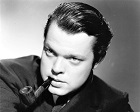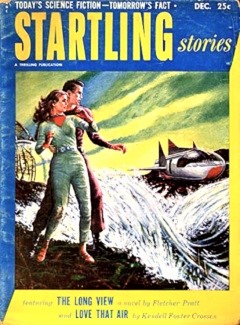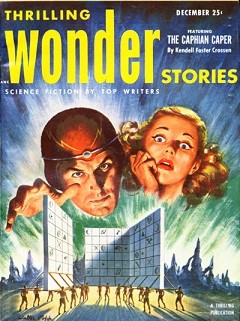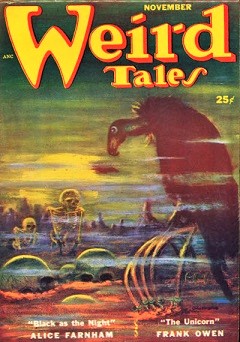
 “The Black Museum. A Repository of Death. Here in the grim stone structure on the Thames which houses Scotland Yard is a warehouse of homicide, where everyday objects . . . all are touched by murder.“
“The Black Museum. A Repository of Death. Here in the grim stone structure on the Thames which houses Scotland Yard is a warehouse of homicide, where everyday objects . . . all are touched by murder.“
The Black Museum (1952) aired (in the United States) “A Straight Razor” on December 14, 1952. This is only the second episode we’ve run of this show (the first being this past January) so a recap of the background from that first episode is in order. The Black Museum was one of four similar shows produced by Harry Alan Towers (1920-2009) under his Towers of London label in the late 1940s and early 1950s. Towers, a native born Britisher, would also produce popular radio fare like Secrets of Scotland Yard, Fabian of the Yard, and WHItehall 1212. All four shows centered around stories from the files of Scotland Yard, and New Scotland Yard’s famous Crime Museum, which was popularized in crime novels as the Black Museum. While all but Fabian of the Yard are verified as being produced and syndicated in Britain for future syndication, it is interesting to note that, according to the Digital Deli Too website entry, “WHItehall 1212 was a National Broadcasting Corporation production written by Lights Out’s famous scriptwriter Wyllis Cooper….” Three of the four shows, The Black Museum among them, would wrap their stories around an artifact from the museum, recounting in dramatic form the infamous crime associated with said artifact. Secrets of Scotland Yard kept to historical facts quite closely, and while a fascinating listen and quite popular, didn’t have the flair or melodramatic effect the likes of Orson Welles (1915-1985) would bring to The Black Museum as the host and narrator of each of its 52 episodes. And while The Black Museum also kept to the historical record surrounding each case, it would play a little fast and loose with them (or perhaps embellish them is the proper word) for dramatic effect, and it didn’t hurt that the show–unlike the others–drew its material solely from murders, thus guaranteeing the audience a chilling half hour. Overlay the grim stories with the somber, virtually hypnotic tones of Orson Welles and you’ve got a winner.

 Speaking of Orson Welles, one might be given to wonder how he came to write some of, and host and narrate all of the episodes of The Black Museum, which were produced in the UK. It seems that Welles decided to take an extended “vacation” in England due to several professional and personal problems, including some “requests” from the Internal Revenue Service. So the American loss turned into Harry Alan Towers’s gain (Towers’s photo at left 1948, at right circa 1984), and he set Welles to work, a profitable solution for both parties. Welles would also work on two other Towers productions, perhaps the most well known to the American radio audience being The Lives of Harry Lime (or The Third Man.) The Third Man was a 1949 film noir British production set in post-World War II Vienna, with Welles playing the Lime character. Written by Graham Greene, it has attained classic status for its stylish portrayal of a decaying and corrupt Vienna, so Towers was striking while the iron was hot and rode the coattails of the film with Welles starring in the radio adaptation.
Speaking of Orson Welles, one might be given to wonder how he came to write some of, and host and narrate all of the episodes of The Black Museum, which were produced in the UK. It seems that Welles decided to take an extended “vacation” in England due to several professional and personal problems, including some “requests” from the Internal Revenue Service. So the American loss turned into Harry Alan Towers’s gain (Towers’s photo at left 1948, at right circa 1984), and he set Welles to work, a profitable solution for both parties. Welles would also work on two other Towers productions, perhaps the most well known to the American radio audience being The Lives of Harry Lime (or The Third Man.) The Third Man was a 1949 film noir British production set in post-World War II Vienna, with Welles playing the Lime character. Written by Graham Greene, it has attained classic status for its stylish portrayal of a decaying and corrupt Vienna, so Towers was striking while the iron was hot and rode the coattails of the film with Welles starring in the radio adaptation.
The airing of The Black Museum episodes presents problems for historians. Produced in 1950, it was first aired as a “pirate broadcast” by Radio Luxembourg, and then throughout Europe. It was eventually licensed by MGM Radio Attractions and ran in the United States under the Mutual Broadcasting System (MBS). MGM hand-picked what it considered to be the best 39 of the original 52 episodes and ran them from January 1, 1952 through December 30, 1952 (with a three month hiatus while a summer replacement filled the gap). This is the run from which we have taken “A Straight Razor.” There’s more to the odd packaging and eventual airing of select episodes of The Black Museum (Canada’s CBC radio would also purchase some 38-39 episodes and air them at different times than the American run, for but one example), but all of that is neither here nor there for our purposes here.
“A Straight Razor” gives us the story of one Larry Wilson, pub owner in 1896 London, and young Mabel, whom he has employed as a bar maid. She is in the bloom of young womanhood while he is the somewhat older man who has fallen in love with her. Despite some initial misgivings, she has agreed to his honest and earnest marriage proposal; Mabel is in fact quite ecstatic about it, going so far as to write her parents about it and inviting them to the wedding. Shortly after their marriage, however, Mabel falls ill and dies, simply withering away. The attending physician rules the death “exhaustion” from Mabel’s initial stomach ailment, at first believed to have been caused from eating bad food. Soon enough, the authorities get involved and…let’s just say that through a peculiar set of circumstances and thorough detective work, poor Mabel’s death is ruled a murder. But how? And who and why (Mabel has left no inheritance so surely there is no motive pointing to her beloved husband)? And most curious of all is the question, Where does the story title’s straight razor come into play? Even the authorities are puzzled. To discover the answer to these questions and how the straight razor (made of the finest Sheffield steel) came to occupy a place in the Black Museum and ends up the focus of this tale, you’ll have to listen to the sordid tale of “A Straight Razor.”

Play Time: 25:15
{Making their final drugstore/newsstand run before Christmas of 1952, the neighborhood gang picked up a few straggler magazines they hadn’t had the chance to bring home on their previous weekly pilgramage. Startling Stories (1939-1955) was a bi-monthly for most of its long run, but 1952 was the first year it attempted a monthly schedule. It lasted through 1952 and through June of 1953, then scaled down to a more or less quarterly schedule until its demise with the Fall 1955 issue. Thrilling Wonder Stories (1936-1955) was still an old favorite, promising colorful action-adventure stories to fire young imaginations. It was a bi-monthly in 1952. Weird Tales (1923-1954) always delivered macabre tales of the supernatural and assorted dark evils, and had proved an excellent companion for late night winter reads. It was a bi-monthly in 1952.}
[Left: Startling Stories, Dec. 1952 – Center: Thrilling Wonder Stories, Dec. 1952 – Right: Weird Tales, Nov. 1952]



To view the entire list of weekly Old Time Radio episodes at Tangent Online, click here.